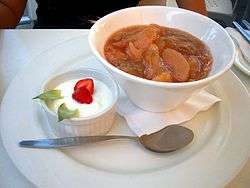Compote
|
| |
| Alternative names | compost (Middle English) |
|---|---|
| Type | Dessert |
| Serving temperature | Warm or chilled |
| Main ingredients | Fruit, sugar syrup, spices |
|
| |
Compote (French for "mixture") is a dessert originating from medieval Europe, made of whole or pieces of fruit in sugar syrup. Whole fruits are cooked in water with sugar and spices. The syrup may be seasoned with vanilla, lemon or orange peel, cinnamon sticks or powder, cloves, other spices, ground almonds, grated coconut, candied fruit, or raisins. The compote is served either warm or cold.
History
Compote conformed to the medieval belief that fruit cooked in sugar syrup balanced the effects of humidity on the body. The name is derived from the Latin word compositus, meaning mixture. In late medieval England it was served at the beginning of the last course of a feast (or sometimes the second of three courses), often accompanied by a creamy potage.[1][2][3] During the Renaissance, it was served chilled at the end of dinner. Because it was easy to prepare, made from inexpensive ingredients and contained no dairy products, compote became a staple of Jewish households throughout Europe.[4]
Kompot remains a popular drink made from homegrown fruit such as apple, rhubarb, plum, sour cherry or gooseberries in Eastern Europe and Russia. Kompot may have been a descendant of a Byzantine dessert.[5]
Variations
The dessert may be topped with whipped cream, cinnamon, or vanilla sugar. The syrup may be made with wine, as in one early 15th century recipe for pear compote.[2] Other preparations consist of using dried fruits which have been soaked in water in which alcohol can be added, for example kirsch, rum, or Frontignan.[6]
See also
- Compote (game dish)
- Fruit fool an English variety
- Kissel
- Kompot
- Tomato compote
- Tong Sui
- List of French desserts
References
- ↑ Constance B. Hieatt and Sharon Butler, ed. Curye on Inglysch. The Early English Text Society, New York, 1985.
- 1 2 Thomas Austin, ed. Two Fifteenth-Century Cookery-Books. The Early English Text Society, New York, 1888 (reprinted 1964).
- ↑ Information on the Coronation feast of Richard III, taken from Sutton, Anne F. and PW Hammond, The Coronation of Richard III: the Extant Documents, New York; St. Martin's Press, 1983.
- ↑ Be Merry / A taste of Poland, Haaretz
- ↑ Food and Drink in Medieval Poland. Rediscovering a Cuisine of the Past. Page 153 – Recipe for pear and fig "kompot" originating from Byzantine Empire, Constantinople, 960A.D-1453A.D., the predecessor of the Ottoman Empire
- ↑ Robuchon, Joël, "Members of the Gastronomic Committee". Larousse Gastronomique. New York: Clarkson Potter/Publishers, 2001, p. 322-323.
